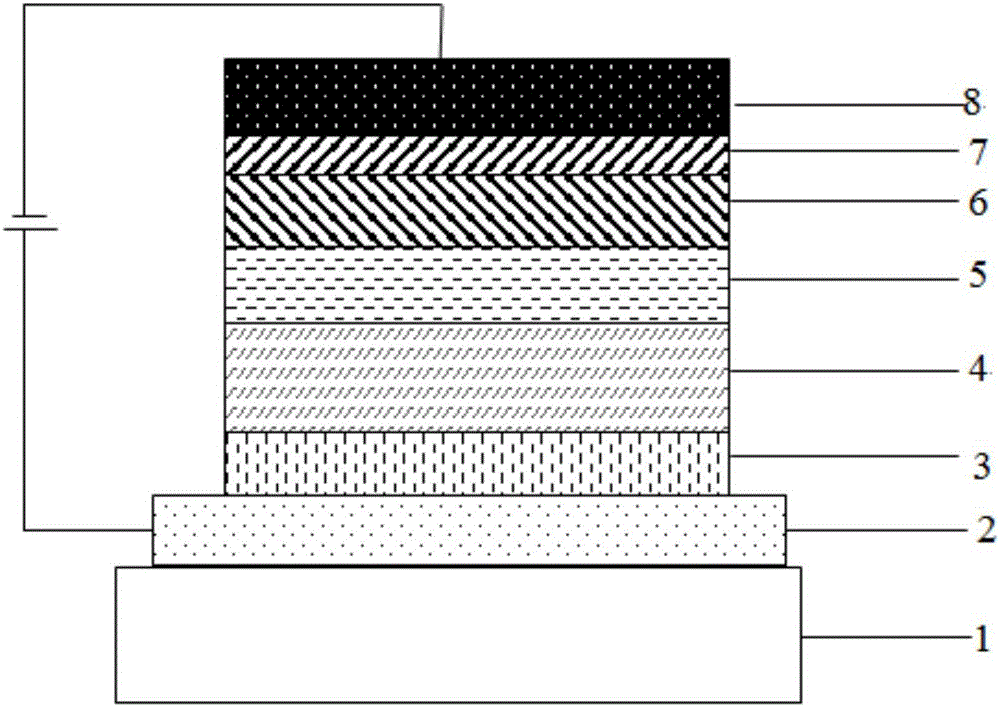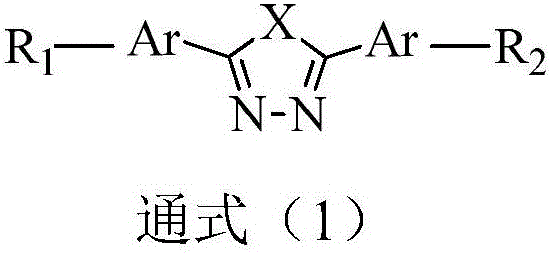Organic electroluminescence compound with nitrogen-containing five-membered heterocycle as core and application thereof
A five-membered heterocycle and compound technology, which is applied to the application field of organic light-emitting diodes, can solve the problems of low S1 state radiation transition rate, efficiency roll-off, difficult exciton utilization rate, and high fluorescence radiation efficiency.
- Summary
- Abstract
- Description
- Claims
- Application Information
AI Technical Summary
Problems solved by technology
Method used
Image
Examples
Embodiment 1
[0075] Embodiment 1: the synthesis of compound 10:
[0076] synthetic route:
[0077]
[0078] In a 250ml three-neck flask, under nitrogen protection, add 0.01mol 2-(4-bromophenyl)-5-phenyl-1,3,4-oxadiazole, 0.012mol intermediate A1, 0.03mol tert-butanol Sodium, 5 x 10 -5 molPd 2 (dba) 3 , 5×10 -5 mol of tri-tert-butylphosphine, 150ml of toluene, heated to reflux for 24 hours, sampled and plated, the reaction was complete; natural cooling, filtration, rotary evaporation of the filtrate, column chromatography to obtain the target product, HPLC purity 98.5%, yield 75.2%;
[0079] Elemental analysis structure (molecular formula C 42 h 26 N 4 O): theoretical value C, 83.70; H, 4.35; N, 9.30; O, 2.65; tested value: C, 83.72; H, 4.33; N, 9.31;
[0080] HPLC-MS: The molecular weight of the material is 602.68, and the measured molecular weight is 602.82.
Embodiment 2
[0081] Embodiment 2: the synthesis of compound 27:
[0082] synthetic route:
[0083]
[0084] In a 250ml three-neck flask, under nitrogen protection, add 0.01mol 3-(4-bromophenyl)-4-methyl-4,5-diphenyl-4H-pyrazole, 0.012mol intermediate B1, 0.03mol Sodium tert-butoxide, 5×10 -5 molPd 2 (dba) 3 , 5×10 -5 mol of tri-tert-butylphosphine, 150ml of toluene, heated to reflux for 24 hours, sampling point plate, the reaction was complete; natural cooling, filtration, filtrate rotary evaporation, column chromatography to obtain the target product, HPLC purity 99.3%, yield 76.3%;
[0085] Elemental analysis structure (molecular formula C 50 h 33 N 3 O): theoretical value C, 86.81; H, 4.81; N, 6.07; O, 2.31; tested value: C, 86.82; H, 4.80; N, 6.05;
[0086] HPLC-MS: The molecular weight of the material is 691.82, and the measured molecular weight is 692.01.
Embodiment 3
[0087] Embodiment 3: the synthesis of compound 37:
[0088] synthetic route:
[0089]
[0090] In a 250ml three-neck flask, under nitrogen protection, add 0.01mol 2-(4-bromophenyl)-5-phenyl-1,3,4-oxadiazole, 0.012mol intermediate C1, 0.03mol tert-butanol Sodium, 5 x 10 -5 molPd 2 (dba) 3 , 5×10 -5 mol of tri-tert-butylphosphine, 150ml of toluene, heated to reflux for 24 hours, sampling point plate, the reaction was complete; natural cooling, filtration, filtrate rotary evaporation, column chromatography to obtain the target product, HPLC purity 98.9%, yield 74.8%;
[0091] Elemental analysis structure (molecular formula C 47 h 34 N 4 O): theoretical value C, 84.15; H, 5.11; N, 8.35; O, 2.39; tested value: C, 84.14; H, 5.12; N, 8.34;
[0092] HPLC-MS: The molecular weight of the material is 670.80, and the measured molecular weight is 670.97.
PUM
| Property | Measurement | Unit |
|---|---|---|
| Thickness | aaaaa | aaaaa |
Abstract
Description
Claims
Application Information
 Login to View More
Login to View More - R&D
- Intellectual Property
- Life Sciences
- Materials
- Tech Scout
- Unparalleled Data Quality
- Higher Quality Content
- 60% Fewer Hallucinations
Browse by: Latest US Patents, China's latest patents, Technical Efficacy Thesaurus, Application Domain, Technology Topic, Popular Technical Reports.
© 2025 PatSnap. All rights reserved.Legal|Privacy policy|Modern Slavery Act Transparency Statement|Sitemap|About US| Contact US: help@patsnap.com



